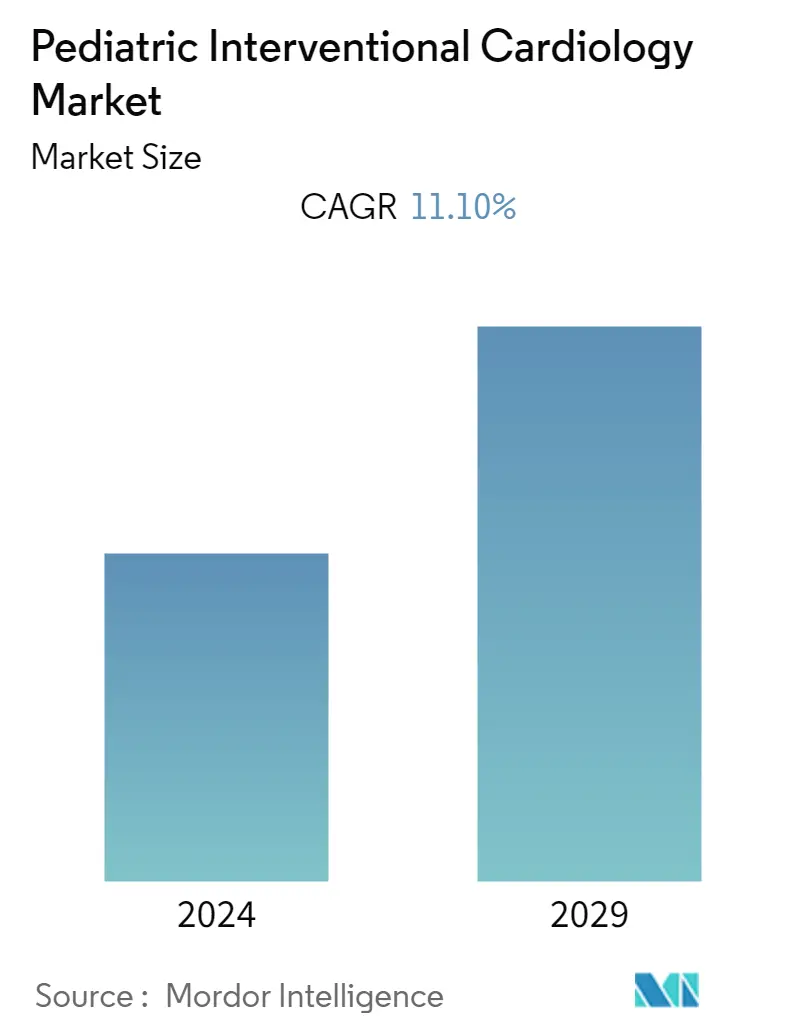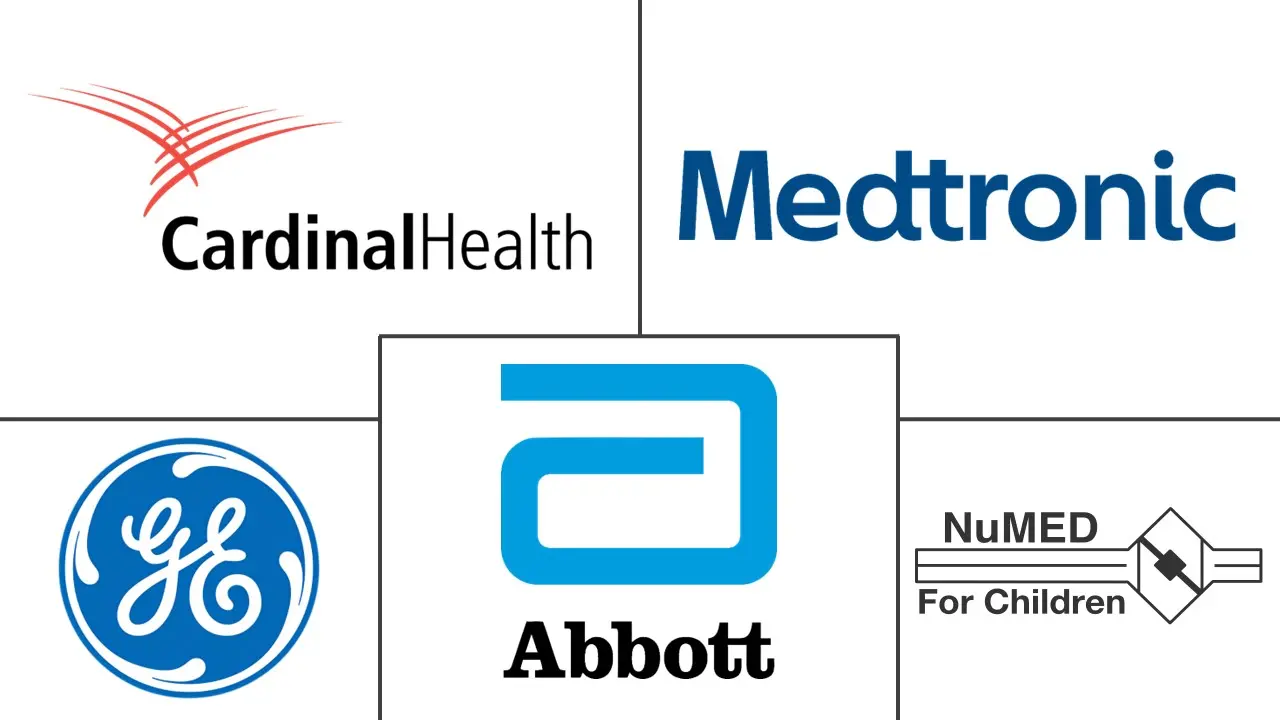Market Size of Pediatric Interventional Cardiology Industry

| Study Period | 2019 - 2029 |
| Base Year For Estimation | 2023 |
| CAGR | 11.10 % |
| Fastest Growing Market | Asia-Pacific |
| Largest Market | North America |
| Market Concentration | Medium |
Major Players
*Disclaimer: Major Players sorted in no particular order |
Pediatric Interventional Cardiology Market Analysis
Over the next few years, the pediatric interventional cardiology market is expected to register a CAGR of 11.1%.
The COVID-19 pandemic had a significant effect on the pediatric interventional cardiology market. Several investigations from throughout the world have reported decreases in hospitalizations and cardiac procedures. For instance, according to an article published by PubMed in August 2022, the pandemic significantly impacted the delivery of pediatric cardiac care across India, with a two-thirds reduction in hospitalizations and cardiac surgeries. Thus, the market was significantly impacted during the pandemic; however, as the pandemic has subsided currently, the hospitals have started their normal procedures. Hence, the studied market is expected to have stable growth during the forecast period of the study.
Market growth is likely to be boosted by things like more people getting heart disease and faster technological progress.
The most prevalent birth problem is congenital heart defects (CHD). According to the data updated by the CDC in January 2022, CHDs affect nearly 1% of newborns, or about 40,000 births per year in the United States. The prevalence (the number of babies born with a heart defect compared to the total number of births) of some CHDs, especially mild types, is increasing, while the prevalence of other types has remained stable. The most common type of heart defect in newborns is a ventricular septal defect (VSD). Thus, the increasing prevalence of CHD is expected to increase the adoption of pediatric interventional cardiology devices.
In addition, new product launches and strategic activities by major players in the market are positively affecting the growth of the studied market. For instance, in July 2021, Abbott launched an occluder, which is a self-expanding wire mesh device that is inserted through a small incision in the leg and guided through vessels to the heart, where it is placed to seal the opening in the heart. It is one of the world's first medical devices that can be implanted in the tiniest of babies (weighing as little as 700 g) using a minimally invasive procedure to treat patent ductus arteriosus, or PDA.
Thus, the abovementioned factors, such as increasing heart disease and new product launches and strategic activities by major players in the market, are expected to increase the market's growth. However, stringent regulatory policies and expensive treatments and therapies are likely to hamper the growth of the pediatric interventional cardiology market.
Pediatric Interventional Cardiology Industry Segmentation
As per the scope of the report, interventional cardiology is the sub-specialty of cardiology that uses intravascular catheter-based techniques with fluoroscopy to treat coronary artery, valvular, and congenital cardiac diseases. Pediatric interventional cardiology refers to the process of performing interventional cardiology on infants, children, and adolescents up to 18 years of age. Various procedures that can be performed under interventional cardiology include angioplasty, valvuloplasty, congenital heart defect correction, and coronary thrombectomy. The pediatric interventional cardiology market is segmented by device type (closure devices, transcatheter heart valves, atherectomy devices, catheters, balloons, stents, and other device types), procedure (catheter-based valve implantation, congenital heart defect correction, angioplasty, coronary thrombectomy, and other procedures), and geography (North America, Europe, Asia-Pacific, the Middle East and Africa, and South America). The market report also covers the estimated market sizes and trends for 17 different countries across major regions globally. The report offers the value (in USD million) for the above segments.
| By Device Type | |
| Closure Devices | |
| Transcatheter Heart Valves | |
| Atherectomy Devices | |
| Catheters | |
| Balloons | |
| Stents | |
| Other Device Types |
| By Procedure | |
| Catheter-Based Valve Implantation | |
| Congenital Heart Defect Correction | |
| Angioplasty | |
| Coronary Thrombectomy | |
| Other Procedures |
| Geography | ||||||||
| ||||||||
| ||||||||
| ||||||||
| ||||||||
|
Pediatric Interventional Cardiology Market Size Summary
The pediatric interventional cardiology market is poised for significant growth, driven by the increasing prevalence of congenital heart defects and advancements in medical technology. The market experienced a downturn during the COVID-19 pandemic due to reduced hospitalizations and cardiac procedures, but has since rebounded as healthcare services normalize. The rising incidence of congenital heart defects, such as ventricular septal defects, is expected to boost the adoption of interventional cardiology devices. Additionally, the introduction of innovative products, like Abbott's occluder for minimally invasive procedures, is further propelling market expansion. However, challenges such as stringent regulatory policies and the high cost of treatments may impede growth.
In North America, the market is experiencing robust growth due to the high incidence of congenital heart diseases and technological advancements in the field. The increasing pediatric population and initiatives by key market players, such as the FDA's approval of the Harmony Transcatheter Pulmonary Valve, are contributing to market dynamics. The competitive landscape is characterized by major players like Abbott Laboratories, Cardinal Health, and Medtronic, who are expanding their product portfolios through strategic partnerships and acquisitions. These factors collectively underscore the market's potential for growth, despite the challenges posed by regulatory and financial barriers.
Pediatric Interventional Cardiology Market Size - Table of Contents
-
1. MARKET DYNAMICS
-
1.1 Market Overview
-
1.2 Market Drivers
-
1.2.1 Increased R&D Activities Towards Development of Novel Devices
-
1.2.2 Rising Incidences of Congenital Heart Diseases
-
1.2.3 Technological Advancements in Pediatric Interventional Cardiology
-
-
1.3 Market Restraints
-
1.3.1 High Cost of the Procedures
-
1.3.2 Reimbursement and Regulatory Issues
-
-
1.4 Porter's Five Forces Analysis
-
1.4.1 Threat of New Entrants
-
1.4.2 Bargaining Power of Buyers/Consumers
-
1.4.3 Bargaining Power of Suppliers
-
1.4.4 Threat of Substitute Products
-
1.4.5 Intensity of Competitive Rivalry
-
-
-
2. MARKET SEGMENTATION (Market Size by Value - USD million)
-
2.1 By Device Type
-
2.1.1 Closure Devices
-
2.1.2 Transcatheter Heart Valves
-
2.1.3 Atherectomy Devices
-
2.1.4 Catheters
-
2.1.5 Balloons
-
2.1.6 Stents
-
2.1.7 Other Device Types
-
-
2.2 By Procedure
-
2.2.1 Catheter-Based Valve Implantation
-
2.2.2 Congenital Heart Defect Correction
-
2.2.3 Angioplasty
-
2.2.4 Coronary Thrombectomy
-
2.2.5 Other Procedures
-
-
2.3 Geography
-
2.3.1 North America
-
2.3.1.1 United States
-
2.3.1.2 Canada
-
2.3.1.3 Mexico
-
-
2.3.2 Europe
-
2.3.2.1 Germany
-
2.3.2.2 United Kingdom
-
2.3.2.3 France
-
2.3.2.4 Italy
-
2.3.2.5 Spain
-
2.3.2.6 Rest of Europe
-
-
2.3.3 Asia-Pacific
-
2.3.3.1 China
-
2.3.3.2 Japan
-
2.3.3.3 India
-
2.3.3.4 Australia
-
2.3.3.5 South Korea
-
2.3.3.6 Rest of Asia-Pacific
-
-
2.3.4 Middle East and Africa
-
2.3.4.1 GCC
-
2.3.4.2 South Africa
-
2.3.4.3 Rest of Middle East and Africa
-
-
2.3.5 South America
-
2.3.5.1 Brazil
-
2.3.5.2 Argentina
-
2.3.5.3 Rest of South America
-
-
-
Pediatric Interventional Cardiology Market Size FAQs
What is the current Pediatric Interventional Cardiology Market size?
The Pediatric Interventional Cardiology Market is projected to register a CAGR of 11.10% during the forecast period (2024-2029)
Who are the key players in Pediatric Interventional Cardiology Market?
Cardinal Health, Medtronic, Abbott Laboratories, GE Healthcare and NuMED Inc. are the major companies operating in the Pediatric Interventional Cardiology Market.

